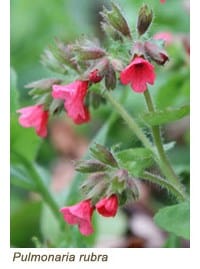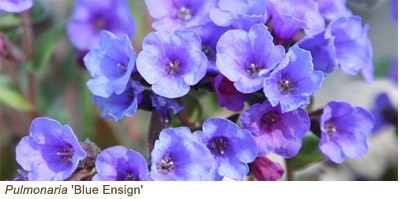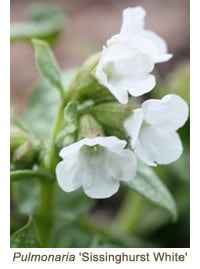Pulmonarias - top of the nectar table
 One plant every gardener should grow is the pulmonaria, or lungwort. It oozes nectar from its flowers, which are held on foot-high stems. Find a place in dappled shade in reasonable soil close to deciduous trees and shrubs, because pulmonarias are basically woodlanders. The evergreen forms produce good foliage throughout autumn and winter, so their rosettes will shelter all manner of small insects. The foliage will get distressed and ragged if given full summer sun though, so nurture your pulmonaria by cutting the foliage right back as they finish flowering. Then, gently tip a bucket of water over them so that they produce sumptuous new leaves for summer. Do not worry about mildew: this is caused by water stress in dry summers and your pulmonarias will recover.
One plant every gardener should grow is the pulmonaria, or lungwort. It oozes nectar from its flowers, which are held on foot-high stems. Find a place in dappled shade in reasonable soil close to deciduous trees and shrubs, because pulmonarias are basically woodlanders. The evergreen forms produce good foliage throughout autumn and winter, so their rosettes will shelter all manner of small insects. The foliage will get distressed and ragged if given full summer sun though, so nurture your pulmonaria by cutting the foliage right back as they finish flowering. Then, gently tip a bucket of water over them so that they produce sumptuous new leaves for summer. Do not worry about mildew: this is caused by water stress in dry summers and your pulmonarias will recover.
These promiscuous plants produce seedlings, so most gardeners deadhead their pulmonarias to prevent too many offspring. Mostly the flowers are white, or pink, or tomato-red or blue, but some have flowers that hover between pink and blue, rather like the forget-me-not. The flowers open pink, but straight after pollination they change to blue, giving them a mottled effect. This two-tone arrangement gave rise to the common name soldiers and sailors, from the days when all soldiers had red uniforms. Other common names inspired by the pink and blue theme are Adam and Eve and Joseph and Mary's. Perhaps the most evocative old name comes from the Isle of Wight, the blue cowslip. Wild colonies of P. longifolia ( the narrow-leaved pulmonaria) can still be seen in the woods there, as well as in Hampshire's New Forest.
Both the plant's botanical name (which comes from pulmo, the Latin for lung) and it's common name, lungwort, makes reference to the plants reputation for curing lung disease. This notion was conceived because the long spotted leaves were thought to resemble diseased lungs. This 16th century doctrine of signatures, used by herbalists, wrongly believed that any plant which resembled an organ would cure that body part.
 The earliest of all to flower is the red-flowered Pulmonaria rubra. A spreading plant with plain green foliage, it is best suited to wilder woodland areas or larger gardens. In clement years this will often begin to shine in January. The April flowering 'Blue Ensign', a gentian blue pulmonaria with dark green foliage, is a better plant for a smaller garden. Discovered at RHS Wisley as a seedling in Bowles' Corner in the 1980s, it produces purple shoots early in the year. Once the rich blue flowers open they make the perfect foil for pallid yellow miniature narcissi such as 'W.P. Milner' and 'Topolino'. Later the acid yellow pouffe, provided by Euphorbia polychroma, will dazzle next to this blue gem.
The earliest of all to flower is the red-flowered Pulmonaria rubra. A spreading plant with plain green foliage, it is best suited to wilder woodland areas or larger gardens. In clement years this will often begin to shine in January. The April flowering 'Blue Ensign', a gentian blue pulmonaria with dark green foliage, is a better plant for a smaller garden. Discovered at RHS Wisley as a seedling in Bowles' Corner in the 1980s, it produces purple shoots early in the year. Once the rich blue flowers open they make the perfect foil for pallid yellow miniature narcissi such as 'W.P. Milner' and 'Topolino'. Later the acid yellow pouffe, provided by Euphorbia polychroma, will dazzle next to this blue gem.
 Highly desirable spotted pulmonarias include the iconic 'Sissinghurst White', the dainty Cambridge blue 'Roy Davison', the red-flowered 'Leopard' and the later flowering, floppy-headed deep-blue 'Bertram Anderson'. Perhaps the finest pulmonaria of all is 'Diana Clare', found as a seedling on Bob Brown's nursery, Cotswold Garden Flowers, and named after his wife. The verdigris foliage is unique, and it sets off the violet flowers beautifully.
Highly desirable spotted pulmonarias include the iconic 'Sissinghurst White', the dainty Cambridge blue 'Roy Davison', the red-flowered 'Leopard' and the later flowering, floppy-headed deep-blue 'Bertram Anderson'. Perhaps the finest pulmonaria of all is 'Diana Clare', found as a seedling on Bob Brown's nursery, Cotswold Garden Flowers, and named after his wife. The verdigris foliage is unique, and it sets off the violet flowers beautifully.
Pulmonarias are members of the borage family. Other nectar-rich family members are Brunnera, Anchusa and borage. Variegated Brunnera 'Dawson's White', named after doctrine of signatures plantsman Douglas Dawson, is a vision of cream and green with sprays of cornflower-blue flowers. 'Jack Frost' has larger blue flowers above marbled silver foliage, crisply edged in green. Both will enjoy coolish dappled shade.



 One plant every gardener should grow is the
One plant every gardener should grow is the  The earliest of all to flower is the red-flowered
The earliest of all to flower is the red-flowered  Highly desirable spotted
Highly desirable spotted 